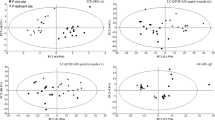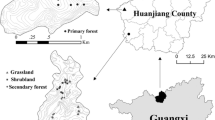Abstract
Ionomics is the measurement of total metal, metalloid, and nonmetal accumulation in living organisms. Plant ionomics has been applied to various types of research in the last decade. It has been reported that the ionome of a plant is strongly affected by its evolution and by environmental factors. In this study, we analyzed the concentration of 23 elements in leaves of 819 plant species (175 families) growing in the Botanic Garden of Hokkaido University, Japan. Relative variation estimated by the coefficient of variation in foliar concentrations of essential elements among various plant species tended to be low, whereas nickel concentration showed exceptionally large relative variation. By contrast, the relative variation in nonessential elements was high, particularly in sodium, aluminum, and arsenic. The higher relative variations in these element concentrations can be explained by the occurrence of plants that are hyperaccumulators for these elements. Differences in life forms such as herbaceous/woody species, deciduous/evergreen woody species and annual/perennial herbaceous species affected the concentration of several elements in the leaves. These differences were considered to be due to the combined factors including differences in lifespan, growth rate, and cell wall thickness of the leaves. Results of principal component analyses (based on concentration data of essential and nonessential elements in leaf samples) indicated phylogenetic influences on plant ionomes at the family level in Polypodiales, Pinales, Poales, and Ericales. Furthermore, when analyzing correlations among concentrations of all elements in each order and comparing among different orders, the results also suggested that Polypodiales, Pinales, and Poales each had a specific ion homeostasis network.




Similar content being viewed by others
Change history
19 February 2021
A Correction to this paper has been published: https://doi.org/10.1007/s10265-021-01267-7
References
Álvarez-Fernández A, Díaz-Benito P, Abadía A, Lopez-Millan A-F, Abadía J (2014) Metal species involved in long distance metal transport in plants. Front Plant Sci 5:105
Asaro A, Ziegler G, Ziyomo C, Hoekenga OA, Dilkes BP, Baxter I (2016) The interaction of genotype and environment determines variation in the maize kernel ionome. G3 Genes Genom Genet 6:4175–4183
Beesley L, Inneh OS, Norton GJ, Moreno-Jimenez E, Pardo T, Clemente R, Dawson JJC (2014) Assessing the influence of compost and biochar amendments on the mobility and toxicity of metals and arsenic in a naturally contaminated mine soil. Environ Pollut 186:195–202
Bouchenak-Khelladi Y, Muasya AM, Linder HP (2014) A revised evolutionary history of Poales: origins and diversification. Bot J Linn Soc 175:4–16
Brady KU, Kruckeberg AR Jr, Bradshaw HD (2005) Evolutionary ecology of plant adaptation to serpentine soils. Annu Rev Ecol Evol Syst 36:243–266
Caille N, Swanwick S, Zhao FJ, McGrath SP (2004) Arsenic hyperaccumulation by Pteris vittata from arsenic contaminated soils and the effect of liming and phosphate fertilisation. Environ Pollut 132:113–120
Carter EL, Flugga N, Boer JL, Mulrooney SB, Hausinger RP (2009) Interplay of metal ions and urease. Metallomics 1:207–221
Chao D-Y, Gable K, Chen M, Baxter I, Dietrich CR, Cahoon EB, Guerinot ML, Lahner B, Lü S, Markham JE, Morrissey J, Han G, Gupta SD, Harmon JM, Jaworski JG, Dunn TM, Salt DE (2011) Sphingolipids in the root play an important role in regulating the leaf Ionome in Arabidopsis thaliana. Plant Cell 23:1061–1081
Chen Z, Watanabe T, Shinano T, Okazaki K, Osaki M (2009a) Rapid characterization of plant mutants with an altered ion-profile: a case study using Lotus japonicus. New Phytol 181:795–801
Chen Z, Watanabe T, Shinano T, Ezawa T, Wasaki J, Kimura K, Osaki M, Zhu YG (2009b) Element interconnections in Lotus japonicus: a systematic study of the effects of element additions on different natural variants. Soil Sci Plant Nutr 55:91–101
Christenhusz MJM, Chase MW (2014) Trends and concepts in fern classification. Ann Bot 113:571–594
Duan G, Hakoyama T, Kamiya T, Miwa H, Lombardo F, Sato S, Tabata S, Chen Z, Watanabe T, Shinano T, Fujiwara T (2017) LjMOT1, a high-affinity molybdate transporter from Lotus japonicus, is essential for molybdate uptake, but not for the delivery to nodules. Plant J 90:1108–1119
Fatiukha A, Klymiuk V, Peleg Z, Saranga Y, Cakmak I, Krugman T, Korol AB, Fahima T (2020) Variation in phosphorus and sulfur content shapes the genetic architecture and phenotypic associations within the wheat grain ionome. Plant J 101:555–572
Garnier E, Vancaeyzeele S (1994) Carbon and nitrogen content of congeneric annual and perennial grass species: relationships with growth. Plant Cell Environ 17:399–407
Guillaume T, Chawla F, Steinmann P, Gobat J-M, Froidevaux P (2012) Disparity in 90Sr and 137Cs uptake in Alpine plants: phylogenetic effect and Ca and K availability. Plant Soil 355:29–39
Haridasan M, Araújo GMD (1988) Aluminium-accumulating species in two forest communities in the cerrado region of central Brazil. For Ecol Manag 24:15–26
Himelblau E, Amasino RM (2001) Nutrients mobilized from leaves of Arabidopsis thaliana during leaf senescence. J Plant Physiol 158:1317–1323
Indriolo E, Na G, Ellis D, Salt DE, Banks JA (2010) A vacuolar arsenite transporter necessary for arsenic tolerance in the arsenic hyperaccumulating fern Pteris vittata is missing in flowering plants. Plant Cell 22:2045–2057
Jansen S, Broadley MR, Robbrecht E, Smets E (2002) Aluminum hyperaccumulation in angiosperms: a review of its phylogenetic significance. Bot Rev 68:235–269
Kochian LV, Piñeros MA, Liu J, Magalhaes JV (2015) Plant adaptation to acid soils: the molecular basis for crop aluminum resistance. Annu Rev Plant Biol 66:571–598
Kronzucker H, Coskun D, Schulze L, Wong J, Britto D (2013) Sodium as nutrient and toxicant. Plant Soil 369:1–23
Marschner P (ed) (2012) Mineral nutrition of higher plants, 3rd edn. Academic Press, San Diego
Mengel K, Kirkby EA (2001) Principles of plant nutrition. Kluwer Academic Publishers, Dordrecht
Neugebauer K, Broadley MR, El-Serehy HA, George TS, McNicol JW, Moraes MF, White PJ (2018) Variation in the angiosperm ionome. Physiol Plant 163:306–322
Norton G, Deacon C, Xiong L, Huang S, Meharg A, Price A (2010) Genetic mapping of the rice ionome in leaves and grain: identification of QTLs for 17 elements including arsenic, cadmium, iron and selenium. Plant Soil 329:139–153
Onoda Y, Wright IJ, Evans JR, Hikosaka K, Kitajima K, Niinemets Ü, Poorter H, Tosens T, Westoby M (2017) Physiological and structural tradeoffs underlying the leaf economics spectrum. New Phytol 214:1447–1463
Pii Y, Cesco S, Mimmo T (2015) Shoot ionome to predict the synergism and antagonism between nutrients as affected by substrate and physiological status. Plant Physiol Biochem 94:48–56
Pii Y, Zamboni A, Dal Santo S, Pezzotti M, Varanini Z, Pandolfini T (2017) Prospect on ionomic signatures for the classification of grapevine berries according to their geographical origin. Front Plant Sci 8:640
Pollard AJ, Reeves RD, Baker AJM (2014) Facultative hyperaccumulation of heavy metals and metalloids. Plant Sci 217–218:8–17
Quadir QF, Watanabe T, Chen Z, Osaki M, Shinano T (2011) Ionomic response of Lotus japonicus to different root-zone temperatures. Soil Sci Plant Nutr 57:221–232
Salt DE, Baxter I, Lahner B (2008) Ionomics and the study of the plant ionome. Ann Rev Plant Biol 59:709–733
Sanità di Toppi L, Meharg AA (2011) Metal(loid) homeostasis, detoxification and tolerance in plants and lichens: advances in understanding mechanisms. Environ Exp Bot 72:1–2
Sasaki A, Yamaji N, Ma JF (2016) Transporters involved in mineral nutrient uptake in rice. J Exp Bot 67:3645–3653
Schmitt M, Mehltreter K, Sundue M, Testo W, Watanabe T, Jansen S (2017) The evolution of aluminum accumulation in ferns and lycophytes. Am J Bot 104:573–583
Shahzad B, Tanveer M, Hassan W, Shah AN, Anjum SA, Cheema SA, Ali I (2016) Lithium toxicity in plants: reasons, mechanisms and remediation possibilities—a review. Plant Physiol Biochem 107:104–115
Smith AR, Pryer KM, Schuettpelz E, Korall P, Schneider H, Wolf PG (2006) A classification for extant ferns. Taxon 55:705–731
Watanabe Y, Iizuka T, Shimada N (1994) Induction of cucumber leaf urease by cobalt. Soil Sci Plant Nutr 40:545–548
Watanabe T, Broadley MR, Jansen S, White PJ, Takada J, Satake K, Takamatsu T, Tuah SJ, Osaki M (2007) Evolutionary control of leaf element composition in plants. New Phytol 174:516–523
Watanabe T, Urayama M, Shinano T, Okada R, Osaki M (2015) Application of ionomics to plant and soil in fields under long-term fertilizer trials. SpringerPlus 4:781
Watanabe T, Maejima E, Yoshimura T, Urayama M, Yamauchi A, Owadano M, Okada R, Osaki M, Kanayama Y, Shinano T (2016) The ionomic atudy of vegetable crops. PLoS ONE 11:e0160273
White PJ, Broadley MR (2003) Calcium in plants. Ann Bot 92:487–511
White PJ, George TS, Dupuy LX, Karley AJ, Valentine TA, Wiesel L, Wishart J (2013) Root traits for infertile soils. Front Plant Sci 4:193
White PJ, Bowen HC, Broadley MR, El-Serehy HA, Neugebauer K, Taylor A, Thompson JA, Wright G (2017) Evolutionary origins of abnormally large shoot sodium accumulation in nonsaline environments within the Caryophyllales. New Phytol 214:284–293
White PJ, Broadley MR, El-Serehy HA, George TS, Neugebauer K (2018) Linear relationships between shoot magnesium and calcium concentrations among angiosperm species are associated with cell wall chemistry. Ann Bot 122:221–226
Yamaji N, Ma JF (2017) Node-controlled allocation of mineral elements in Poaceae. Curr Opin Plant Biol 39:18–24
Yang M, Lu K, Zhao F-J, Xie W, Ramakrishna P, Wang G, Du Q, Liang L, Sun C, Zhao H, Zhang Z, Liu Z, Tian J, Huang X-Y, Wang W, Dong H, Hu J, Ming L, Xing Y, Wang G, Xiao J, Salt DE, Lian X (2018) Genome-wide association studies reveal the genetic basis of ionomic variation in rice. Plant Cell 30:2720–2740
Yu G-R, Miwa T, Nakayama K, Matsuoka N, Kon H (2000) A proposal for universal formulas for estimating leaf water status of herbaceous and woody plants based on spectral reflectance properties. Plant Soil 227:47–58
Zhao N, Yu G, He N, Wang Q, Guo D, Zhang X, Wang R, Xu Z, Jiao C, Li N, Jia Y (2016) Coordinated pattern of multi-element variability in leaves and roots across Chinese forest biomes. Glob Ecol Biogeogr 25:359–367
Acknowledgements
We would like to express our appreciation to Miki Mori for her help with our plant mineral analyses. We also thank the anonymous reviewers and Prof. Takayoshi Koike for their constructive feedback and helpful comments. The study was partly supported by JSPS KAKENHI (Grant number 20K05762) to TW.
Author information
Authors and Affiliations
Contributions
TW designed the research. TW and TA conducted field work. TW analyzed elements in leaf and soil samples. TW conducted data analysis. TW and TA wrote the manuscript.
Corresponding author
Ethics declarations
Conflict of interest
The authors have declared that no competing interests exist.
Additional information
Publisher's Note
Springer Nature remains neutral with regard to jurisdictional claims in published maps and institutional affiliations.
The original online version of this article was revised due to units were processed incorrectly in tables 2, 3, 4 and corrected in this version.
Supplementary Information
Below is the link to the electronic supplementary material.
Rights and permissions
About this article
Cite this article
Watanabe, T., Azuma, T. Ionomic variation in leaves of 819 plant species growing in the botanical garden of Hokkaido University, Japan. J Plant Res 134, 291–304 (2021). https://doi.org/10.1007/s10265-021-01254-y
Received:
Accepted:
Published:
Issue Date:
DOI: https://doi.org/10.1007/s10265-021-01254-y




